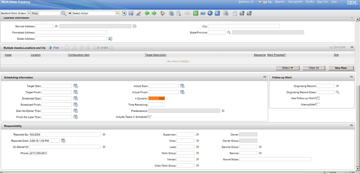In my world, many of the challenges I’ve worked to help resolve are all rooted in the same problem: visibility. I’ve used metaphors like “needle in the Maximo haystack” and “Where’s Waldo?” and I’m sure many Planners and Schedulers reading along were thinking, “Yup! That’s exactly what it’s like.”
I can’t stress enough that what you can see quickly, clearly, and easily in one screen will define how productively you can work. What you can't see will define how miserable you'll be while you're at it. (In fact, studies find that happy employees are more productive.)

Planners and Schedulers often need information that is not directly related to the record they’re dealing with or is not even available at the record level. A basic example of this would be, “How many vacation days does this maintenance technician have left?” One would have to look at the contract to see how many days the technician is allotted and write that number down on a post-it note. Then, look in Maximo CMMS or another application to see how many days have been taken. Write that number down on another post-in note and that still doesn’t tell you how many vacation days are left. Now, you have to break out Excel to do the math! See where I’m going with this? All you want is just to see the number right there in the screen instead of having to look all over and do a calculation to figure it out.
Of course, the example above is “simple” math, but it gets complicated quickly when it’s hundreds of technicians, loads of data and complex calculations.
Manual Calculations Are So 1990
These calculations can be performed at the database level to simplify how data is displayed to Planners, Schedulers, or others to perform their daily functions. This can be visualized via reports, webpages, or any other tool. Here at Prometheus Group, we use the Prometheus Routine Maintenance to enhance the visibility of the Maximo data. With Scheduler, we can create all the calculated fields that are needed to make a Planner or Scheduler’s life easier, plus color coding, grouping, and sorting, among others, all of this based on calculated or regular fields. This is immensely powerful, because the visual elements help to convey a lot of information, without adding more fields or words to an already jam-packed screen.
Here’s what I like about calculated fields.
What Calculated Fields Can Do
1. They Translate Know-How Into Documented Processes
A lot of the organizations I’ve worked with have vast amounts of collective wisdom. Information gets passed by word-of-mouth, habits, informal, undocumented training, and “we’ve always done it this way” culture – but, nobody knows where it came from or why it is the way it is. Know-how is the way they work, sure, but it has disadvantages. It’s hard to quantify, clarify, or explain to others. It leaves a lot of wiggle room for misunderstanding and misinformation. A custom calculation means you need to come together as a team to define what a value is or isn’t.
2. They Reduce The Effort and Time Needed to Convey Information
If a picture says a thousand words, then the right color coding or a check box can say at least a few hundred. Once your team knows how all of these attributes are defined and what they mean, they can read it at light speed. Without having to scroll and search for information or do the calculations manually, they can work a lot faster, too.
3. They Reduce The Chance of Human Error
Say "Goodbye!" to discrepancies and errors. The great thing about a calculated field is that the calculation is repeatable and consistent. You take the time to figure out how to do the calculation and then get everyone working with the same one. Once it’s been set up, it’s always going to run the same way every time. Everyone’s working with the same calculation every time, instead of little errors or differences that can creep in when it’s done manually. Have you ever tried to find a typo in an Excel equation that you didn’t write? Been there. Done that. Never again.
Great Instances To Use Calculated Fields
Calculated fields can be the perfect way to simplify many scenarios Planners and Schedulers face. The sky’s virtually the limit, but here are a few common examples that I think work well:
- Run-to-failure asset
- The age of the asset
- Is the asset on warranty?
- Days remaining of vacation
- Display the cost of a WO
- Overtime based on employee rank
- How long to the next PM?
- The total hours spent on a WO
- Compare estimated and actual hours
- Create custom flags
Please remember that this concept works everywhere – you can use it on any database (Oracle or SQL), in MS Excel, and in countless other applications to make your life easier. I have used it with customers that generate reports out of views or subsets of data from large tables with great success. It also works when taking snapshots of data; I’ve used it for tracking at the record level when the snapshot was taken to be able to perform comparison between snapshots.
All in all, calculated fields are a powerful tool to see more in one screen and move yourself up on that Happiness & Productivity graph – because when you can see more, you can do more.

-1.png?length=360&name=63592abcd13b8dd105fd2e9a_MicrosoftTeams-image%20(46)-1.png)